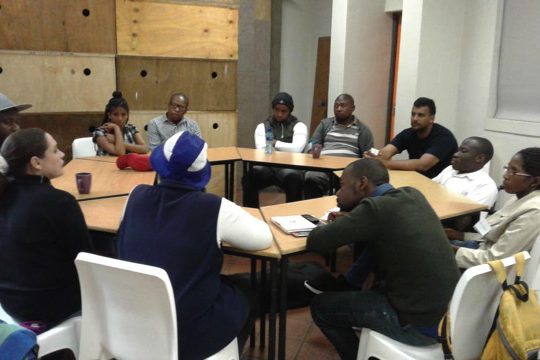
Touch is important for a person who is visually impaired. It is one of the easiest ways to discover information about an object or the environment, either using your fingers or the tip of a white cane. But touch is also fundamental to the way a blind person communicates with other people. Which adds yet another level of complexity to the way we operate as we try to safeguard ourselves against COVID-19.
What do I mean by that?
When a sighted person is taught how to attract the attention of someone who is visually impaired, they are told to lightly touch the person on the arm or shoulder, and then identify themselves. Obviously, this isn’t an option when trying to social distance. Here’s a few suggestions I think might be an alternative.
Let’s say you are walking down a street with several people around, and see me approaching. If you know me, you can simply call out my name to attract my attention – from a safe distance, of course.
If you don’t know my name, it becomes harder. Unless I have Fiji with me, in which case I’ll probably take notice if anyone refers to me as the woman with the guide dog – I mean, how many women with guide dogs are likely to be nearby?
If I don’t have Fiji with me and you need to attract my attention, you could try referring to something specific about me or what I’m wearing – like calling me the lady in the red jersey, or woman in the blue raincoat. If you just try to attract my attention by calling out, “Excuse me!” I’m probably not going to pay attention – I’ll assume you’re talking to someone else and just continue on my way.
So, if you’re trying to attract my attention without needing to touch me, call out to me from a safe distance in a way that I know it’s me you’re talking to.
Touch is also fundamental when a visually impaired person is being guided by someone who is sighted. Even though we are trying to avoid unnecessary trips away from home, sometimes they are necessary. And sometimes we need a sighted person to guide us.
When this happens, the blind person would usually place a hand lightly on either the elbow or the shoulder of the person guiding them. Again, here are my thoughts on a few alternatives, taking the risk of COVID-19 into account.
Depending on the particular situation and what the people involved are comfortable with, there are several ways of guiding a visually impaired person. In the ideal world, a sighted assistant could walk a few steps ahead or beside me, and I would use my white cane or Fiji to follow them. It would make it easier to do so if the sighted assistant speaks or gives some other audio cue for me to follow. That way there would be no physical contact between me and the sighted assistant.
There are other ways to do it – using my white cane as a form of tether with each of us holding one end or, using some other form of tether like blind runners do. That way there would be some distance between me and the sighted assistant, while still giving us a secure way of remaining connected.
As a final suggestion, if physical contact cannot be avoided, I’d probably rather place a hand on the sighted guide’s shoulder and walk slightly behind them. Especially with the current recommendation to cough into your elbow, I’m certainly not going to be holding anyone there.
.
As always, it’s best to ask the individual visually-impaired person what works for them – these are my preferences, but we are all different. So, it’s best to ask.
I’d like to thank members of the LCS Assistive Technology community for sharing their ideas on both these questions – I really appreciated your confirming my thinking on these topics.





